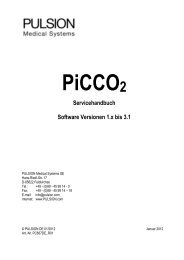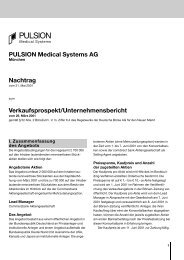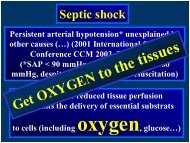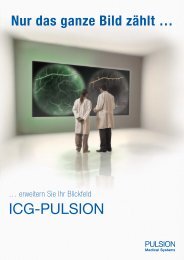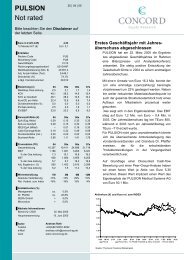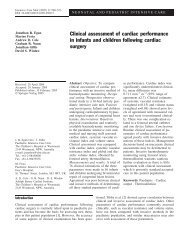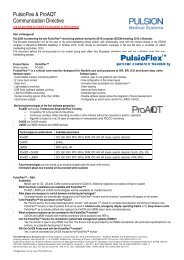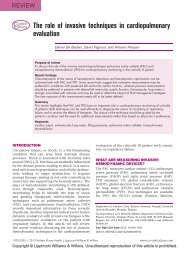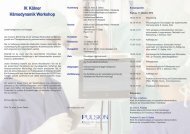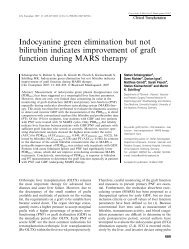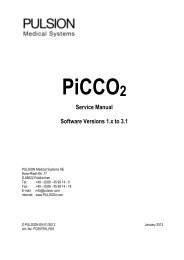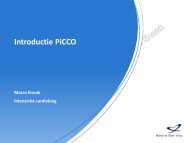download as .pdf - PULSION Medical Systems SE
download as .pdf - PULSION Medical Systems SE
download as .pdf - PULSION Medical Systems SE
You also want an ePaper? Increase the reach of your titles
YUMPU automatically turns print PDFs into web optimized ePapers that Google loves.
CVP, Blood Pressure and Urine Output:<br />
Are they ever enough? (interactive session)<br />
Background<br />
When caring for critically ill patients, the question of hemodynamic<br />
monitoring is a cardinal one. We have to <strong>as</strong>sess and decide<br />
whether the tools at our disposal are adequate for the clinical<br />
scenario at hand. Clearly it makes sense that in the most severely<br />
compromised patients, there is a need for information regarding<br />
cardiov<strong>as</strong>cular and pulmonary function. Unfortunately,<br />
the situations in which these me<strong>as</strong>urements can be helpful and<br />
sometimes even mandatory and in which this information may<br />
improve outcome, are not clearly established. In this presentation<br />
I have attempted to look at the question of whether b<strong>as</strong>ic<br />
monitoring tools are ever enough.<br />
Question 1: ---Are blood pressure, urine output<br />
and central venous pressure ever enough?<br />
80<br />
60<br />
40<br />
20<br />
0<br />
Yes, they can be enough<br />
in many patients<br />
*Results (in%) of the votes of an interactive session (audience 300) during ISICEM, 2012<br />
C<strong>as</strong>e Study 1<br />
No, they are<br />
never enough<br />
The first example of a trauma c<strong>as</strong>e illustrates this point. A 25<br />
year old male is injured by a car and brought into the Emergency<br />
Room (ER) with chest and head injuries. In the ER the<br />
following parameters were me<strong>as</strong>ured;<br />
Blood pressure 86/50<br />
CVP 4 cmH 0 2<br />
Urine Output 30 ml/hr<br />
Dr. Eran Segal, MD<br />
Director, Department of Anesthesia, Critical Care and Pain Medicine, Assuta <strong>Medical</strong><br />
Centers, Israel<br />
Dr. Segal is the director of anesthesia, Intensive Care and Pain Medicine of Assuta <strong>Medical</strong><br />
Centers, in Israel. Dr. Segal w<strong>as</strong> trained in the Sheba <strong>Medical</strong> Center, and in Gainesville, Florida.<br />
He is the President of the Israeli Society of Critical Care Medicine. His main interests are<br />
advanced hemodynamic monitoring and mechanical ventilation.<br />
I have never<br />
needed anything else<br />
Question 2: What is the probable diagnosis?<br />
100<br />
80<br />
60<br />
40<br />
20<br />
0<br />
Septic shock<br />
Anaphylactic<br />
shock<br />
Hemorrhagic<br />
shock<br />
*Results (in%) of the votes of an interactive session (audience 300) during ISICEM, 2012<br />
As the audience thought, the diagnosis here is quite clear, and<br />
in fact <strong>as</strong> reflected by the history, blood pressure, urine output<br />
and CVP in this instance are enough.<br />
Question 3: What should be done?<br />
100<br />
80<br />
60<br />
40<br />
20<br />
0<br />
Administer<br />
fluids<br />
Urine<br />
electrolytes<br />
PA catheter<br />
*Results (in %) of the votes of an interactive session (audience 300) during ISICEM, 2012<br />
In this instance the CVP and blood pressure were accurate<br />
reflectors of his hypovolemia. But we probably didn’t need them<br />
anyway given his clinical presentation. Again, the data and the<br />
history are enough in this c<strong>as</strong>e to evaluate his status and formulate<br />
a plan.<br />
However, things are not always so simple.<br />
Cardiogenic<br />
shock<br />
PiCCO



